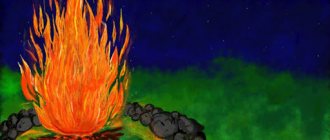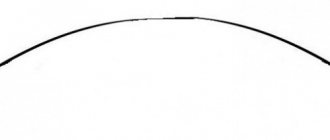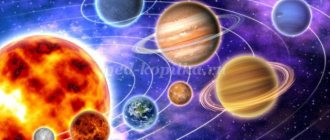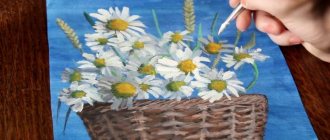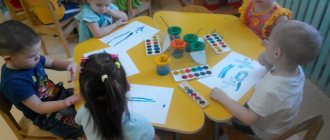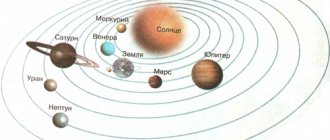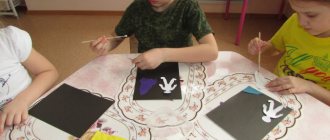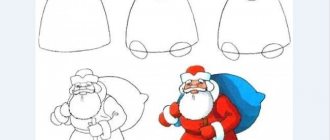Preview:
Municipal budgetary preschool educational institution
"Kindergarten of compensatory type No. 21"
Summary of direct educational activities for the implementation of the educational field “Artistic Creativity”
(senior preschool age)
drawing "Starry sky"
Snezhinsk 2012-2013
Topic: Subject drawing using drawing techniques
raw "Starry Sky"
In the educational field "Artistic Creativity"
- Teach children to depict the starry sky.
- Choose your own color scheme for the stars and background for the night sky.
- Improve technical wet drawing skills.
- Strengthen skills in working with watercolors and wax pencils
- Develop skills of careful and careful handling of materials.
- Develop artistic taste and aesthetic perception by looking at photographs of the starry sky.
In the educational field "Communication"
- Consolidate vocabulary on the topic “Space”
- Strengthen children's ability to answer questions in complete sentences.
- To develop children’s ability to select adjectives for nouns.
In the educational field "Socialization"
- Form the image of “I”, primary gender ideas (boys are masculine, girls are feminine.)
- To instill in children a culture of gender relations.
- Foster a culture of friendly relations in the children's team.
In the educational field "Cognition"
- Strengthen children's knowledge about space, astronauts, stars.
- To consolidate children's knowledge about the properties of a wax pencil.
- Develop fine motor skills of the hands.
In the educational field "Health"
- Preserve and strengthen the physical and mental health of children using finger exercises.
In the educational field "Physical culture"
- Develop dexterity and eye when playing with the ball
Integrative qualities of children: to develop curiosity, mental and speech activity, independence, proficiency in dialogical speech, and the ability to manage their behavior.
Methods and techniques: Org. moment, game "Getting to know each other", showing a photograph, analyzing and showing a sample, questions, working with wax crayons and watercolors, exhibition, result.
Health-saving technologies: finger gymnastics (Sudzhok balls)
Individual work: with Edik and Zakhar, follow the sounds.
Differentiated approach: for 1 subgroup. — offer larger format paper.
Preliminary work: conversation about space, about the first cosmonaut of the Earth Yu.A. Gagarin, about the female cosmonaut V.V. Tereshkova, experimenting with a wax pencil (properties of a wax pencil).
Progress of direct educational activities
Educator: - Look at each other and smile, give a good mood.
Educator: - I have a ball in my hands, we will throw it, calling ourselves and
say who you dream of becoming. Educator: - I'll start first.
Educator: - I am Irina Aleksandrovna, I so dreamed of being a teacher and I became one.
Educator: - And you? (passes the ball to the child standing next to him)
Children: - I am Zakhar, I dream of becoming......
Children: - I am Nastya, I dream of becoming.....etc. 2. Main part.
Educator: - Yes, you each have your own dream.
Educator: - Do you remember I told you a story about a little boy Yura who had an unusual dream?
Educator: - What did Yura dream about?
Children: - Yura dreamed of becoming an astronaut and seeing the starry sky.
Educator: - Did his dream come true?
Children: - His dream came true, he became an astronaut.
Educator: - Boys, which of you would like to become an astronaut like Yu.A. Gagarin?
Educator: - What do you need to be like to become an astronaut?
Children: - Strong, brave, courageous, hardworking, smart.
Educator: - But not only men flew into space, remember who else flew into space?
Educator: - Do you want to know? (children sit in front of the easel)
Educator: - Look how few chairs there are. What should we do, who should we invite to sit on them? (The children’s suggestions are listened to, after which the boys invite the girls to sit and bring chairs for themselves.)
Educator: - Well done, boys, you did everything right!
Educator: - Not only men, but also women conquered space. The first female cosmonaut was Valentina Vladimirovna Tereshkova. Tereshkova became a role model for all women. (Photo)
Educator: - Girls, which of you would like to become an astronaut?
Educator: - What do you need to be like to become an astronaut?
Children: - You need to be strong, brave, courageous, smart...
Educator: - But at the same time she remained a gentle, caring, affectionate, loving mother and wife.
Educator: - So not only boys and men can be strong, brave, courageous, but girls and women can also be strong, brave, courageous...
Educator: - But we won’t be able to go to space with you, but we can draw it.
Educator: - Would you like to draw a starry sky?
3. Sample display and analysis
Educator: - All stars are very different, both in size and temperature. Stars are balls of fire, some hotter than others. That's why the stars have different colors. In the night sky, the stars twinkle with different lights. Have you seen how? (photos of the starry sky)
Children: - The stars twinkle in blue, white, yellow, red.
Educator: - So, what kind of stars are they?
Children: - The stars are colorful, bright, beautiful.
Educator: - Look how I painted the starry sky.
Educator: - In my drawing, the stars are the main object and will occupy most of the composition.
Educator: - What did I use to draw the stars?
Children: - You drew stars with a wax pencil.
Educator: - Don’t forget that the stars are multi-colored and different in size.
Educator: - Then I moisten a sheet of paper with water, using a wide brush, and only then apply black or blue watercolor on top of the drawing, leaving no unpainted areas. Artists call this drawing technique “raw.”
Educator: - How do you understand the word “raw”?
Children: - Wet, wet.
Educator: - Who knows why the watercolor did not paint over the stars?
Children: - Because a wax pencil contains wax, and it repels any liquid from its surface.
Educator: - Before starting work, let’s warm up our hands (Sudzhok balls).
Educator: - And if your hands get tired, then you can rest (roll wax pencils between your palms).
4. Working with wax pencils and watercolors.
(music background is created)
Educator: - Sit in your seats, do not forget that your back should be straight, your legs should be side by side (boys help move the chairs for girls)
Educator: - Remember where you will start your work, what color the stars are, the stars should occupy most of the sheet.
Children's works are placed on the board, children are invited to examine them
Educator: - And our dream also came true today, like Yuri Gagarin, let's admire your works, what a beautiful sky you painted.
Educator: - What is this drawing technique called?
Educator: - Girls, who liked what work and why?
Educator: - Boys, who liked what work and why?
Educator: - I liked all the works.
Educator: - The boys are great, the girls are smart, the work is all different, not alike, everyone got their own starry sky!
Educator: - And at home you can teach how to draw mom and dad.
Source
Summary of a lesson in visual arts for middle group children (4–5 years old) “Starry Sky”
Irina Frolova
Summary of a lesson in visual arts for middle group children (4–5 years old) “Starry Sky”
Goal: to consolidate the ability to mix two colors (white and blue)
to obtain a blue tint.
Objectives: develop the ability to distinguish and name colors and shades.
Maintain interest and desire to experiment with color (mix two colors on the palette)
.
To develop in children the ability to observe the world around them and transfer their impressions into drawings in a form accessible to them.
Preliminary work: review books and illustrations about space with children , introduce them to the concept of palette and the method of obtaining a blue tint.
Materials for the lesson : a toy monkey in a space suit, a large sheet of thick paper, divided into parts of different shapes, covered with dark purple ink, gouache, palettes, brushes No. 3.
Progress of the lesson : a monkey appears and talks about how he wants to fly into space, but for now he is watching the stars through a telescope.
Educator: Children, have you seen the starry sky ? What is it like? (children's answers)
.
Educator: You are right, the stars shimmer in different colors and shades. They can be yellow, red and blue. Let's draw a lot of beautiful stars together with the Monkey.
Educator: Oh, our monkey says that he doesn’t know how to draw stars and doesn’t know where to find blue paint. Tell her how to draw stars (children's answers, and this diagram will help you get blue paint (introduce a familiar scheme for mixing paints)
Children choose sheets of paper of the shape they like, mix their own paints and draw stars of different sizes and types. The teacher prompts and helps as needed.
Educator: You have made wonderful drawings and I will tell you a secret, if you put all the parts together, you will get a big picture of the starry sky !
(on the floor, children assemble a whole picture from individual parts, according to the principle of cut pictures, examine and share their impressions of what they saw)
Educator: The monkey thanks you and promises to come to you again to draw.
teacher of MADOU No. 20
Pankovka village, Novgorod district, Novgorod region
Didactic game “Solve examples” in fine arts. This game is intended for children of middle preschool age. Goal: learn to mix paint colors. Description: Each example shows. Games on the topic: “Specifying the color of objects” To teach children how to use a palette, mix paints, and get many different shades, you need to create these for them.
Source
On the topic: methodological developments, presentations and notes
An integrated final lesson-celebration in the preparatory group for art and physical education, dedicated to the 65th anniversary of the victory. Children do a lot of collective work using both traditional ones.
The integrated lesson “And the sky without birds is not the sky, and the sea without fish is not the sea, and the earth without animals is not earth” was conducted in a preparatory group for school. The lesson uses riddles and poetry.
Summary of an integrated lesson on the topic “What do we see in the sky?” (integration of types of children’s activities: playful, cognitive, communicative, productive.) Goal: To develop children’s cognitive skills.
· Expansion of vocabulary · Introduce children to the symbolism of constellations accepted by astronomers, cultivate a love of nature.
GCD plan No. 18 “.Autumn. Migratory birds" "Clouds in the sky" (gouache) Integration of educational areas: "Health", "Physical education", "Safety", "Cognition", "Communication.
Integrated direct educational activities in the senior group (educational area “Cognition”, “Physical Education”, “Reading Fiction”, “Artistic Creation.
Source
notes on drawing “Starry Sky”
SUMMARY OF NODS
for teaching non-traditional drawing techniques (poking)
«STARRY SKY»
(junior group)
Completed by the teacher
Tolkacheva N.S.
SUMMARY of GCDs for teaching non-traditional drawing techniques (poking)
"STARRY SKY".
Goal: Teaching children non-traditional drawing techniques.
Tasks:
Educational: Introduce the technique of drawing with pokes. Learn to place a poke on the paper.
Educational: Develop fine motor skills. Contribute to the development of children's creativity.
Educational: To cultivate accuracy when working with gouache.
Materials and equipment: computer, poster with the image of the starry sky, the month, space music, starry sky projector, blue toned paper; yellow gouache; a glass of water; pokes; hand wipes
Progress of the lesson:
Organizational part.
The lullaby “Sleep, my joy, fall asleep” sounds. The teacher and the children discuss the words of this lullaby
Sleep, my joy, sleep. The lights went out in the house, the birds fell silent in the garden, the fish fell asleep in the pond. The moon is shining in the sky, The moon is looking out the window. Close your eyes quickly, sleep, my joy, sleep.
Educator: The lullaby says that everyone is sleeping. When does this happen (children's answers)
Educator: How do we know that night has come and it’s time to go to bed? (children's answers)
Educator: Do you think everyone sleeps at night? (children's answers)
But it turns out that there is one family that does not sleep at night, but walks, but not on the earth, but in the sky.
On clear nights, a mother and her daughters walk.
She doesn’t repeat to her daughters: “Go to bed, it’s late!”
Because the mother is the moon, and the daughters are stars.
The teacher draws the children's attention to a poster depicting a starry night sky with a moon and a month. Usually at night we sleep in our cribs, but today I invite you to go on a journey through the starry sky.
In the group, the lights are dimmed, a soft cosmic melody is turned on, the starry sky is projected onto the ceiling and the teacher shows a presentation about the starry sky. Then the teacher invites the children to take space chairs and go on a journey through the starry sky.
Practical part
Educator: The stars are far from us in the sky, so they seem very small. To make our fingers draw beautifully, let's play with them:
Finger gymnastics
The stars fell asleep and suddenly
They illuminated everything around (sitting at the tables, raise your arms up with support on your elbows, clench your fingers into fists and unclench them, spreading them out like a fan and clench them again.)
We played a little, and now let's get down to business. In front of you are sheets of blue paper. But there are no stars in our sky! Let's draw them, take a stick, carefully dip it in yellow paint and press it to a sheet of cardboard. We got a starry sky.
Summary of a drawing lesson in the preparatory group of a kindergarten. Cosmonautics Day
Drawing lesson in a preparatory group on the topic “Space”
Topic of the lesson: Cosmonautics Day Goal: Develop the ability to reflect your ideas about space in a drawing. Objectives: 1. Continue to expand children's understanding of the diversity of space. Tell children about interesting facts and events of space. 2. Give children the idea that the Universe is made up of many stars. The Sun is the star closest to Earth. Clarify ideas about planets and constellations. 3. To give children knowledge about human exploration of outer space, about the importance of space research for the life of people on Earth. Introduce the first cosmonaut Yu.A. Gagarin. 4. Foster a sense of pride for your homeland. It's so cool in space! It's so cool in space! Stars and planets In black weightlessness Float slowly! It's so cool in space! Sharp rockets at great speed, rushing here and there! It's so wonderful in space! It's so magical in space! Been to real space once! In real space! In the one that saw through, In the one that saw through a paper telescope! O. Akhmetova One of the topics that is very interesting for preschool children is space. Space is a mysterious world of stars, planets, and other objects. From childhood, children see that day gives way to night. The sun shines in the sky during the day and the moon at night. And the sky is strewn with many stars. What can you tell children about space?
On April 12, Russia celebrates Cosmonautics Day to commemorate the first space flight accomplished by Yuri Gagarin. The starry sky has always attracted the eyes of people, beckoning with its uncertainty. People dreamed of learning as much as possible about space. Thus began the time of space rockets, satellites, lunar rovers... Our Earth is a huge ball on which there are seas, rivers, mountains, deserts and forests. And also people live. Our Earth and everything that surrounds it is called the Universe, or space. In addition to our blue planet, there are others, as well as stars. Stars are huge balls of light. The sun is also a star. It is located close to the Earth, so we see it and feel its heat. In addition to the Earth, there are 8 more planets in the solar system, each planet has its own path, which is called an orbit. To find out what a person will have to face in space, scientists sent animals for “reconnaissance”. There were dogs, rabbits, mice, even microbes. Dogs are smarter animals than mice, but not all dogs were suitable for testing. Ordinary mongrels came closest. The first dog, Laika, was sent into space in 1957. Then Belka and Strelka flew into space. In 1960, on August 19, they were launched into space on the prototype of the Vostok spacecraft. They stayed in space for more than a day and returned safely. The first cosmonaut was Yuri Alekseevich Gagarin. On April 12, 1961, he flew into space on the Vostok-1 spacecraft and circled the Earth in 1 hour and 48 minutes. Came back alive and healthy. An astronaut is a person who tests space technology and works in space. Now there are astronauts in many countries. The first spacewalk was made by Alexei Leonov in 1965. And the first female cosmonaut was Valentina Tereshkova, who flew into space in 1963. To fly into space, you need to study a lot and study well, be persistent, patient, and enduring. The space theme contains a lot of ideas for drawings, and our children from the preparatory group shared their impressions of space.
We recommend watching:
A game for children in the preparatory group for Cosmonautics Day. Scenario Entertainment for children of the preparatory group. Solar system Sports festival for Cosmonautics Day for the preparatory group of kindergarten. Scenario Notes on cognitive development on the topic: Space in the preparatory group
Similar articles:
Leisure time in mathematics in the preparatory group for Cosmonautics Day
Cosmonautics Day in kindergarten. Scenarios
GCD move:
- Hello guys! I am the Star Fairy ! I invite you to take a flight across the starry sky . Take your seats on our magical spaceship ! Our space journey begins.
(Quiet cosmic music sounds)
.
— While our magical spaceship enters low-Earth orbit, I will ask you a riddle: “The peas scattered along a hundred roads.
No one will collect it -
— Stars.
— At what time of day are the stars most noticeable ?
- How many of you watched the stars ?
- Let's watch together. Look out the porthole. Here it is, what a starry sky !
The guys look at illustrations of the starry sky .
— On a cloudless, clear evening, the sky above your head is strewn with many stars . They appear to be small sparkling dots because they are very far from the Earth.
- In fact, stars are huge hot balls of gas, similar to the Sun. The hottest of them are blue, less hot than the Sun - red. Stars differ in size from each other. There are stars - giants , and there are stars - dwarfs .
— Would you like to have a piece of a beautiful starry sky ?
- I, Star Fairy , can help you with this!
— We stop our spaceship , and I invite you to come to my creative workshop.
- Take a seat. I have magical objects in my workshop:
stick - drawing pen and sponge - washcloth .
— First, with a magic wand, we draw stars : round, in the shape of a flower, with shading. Fill out the entire sheet. They can be different in size.
— As you can see, the resulting pictures are amazingly beautiful and unusual.
“I see, my little friends, you can’t wait to get to work yourself.” Feel free to pick up sticks - drawing sticks !
“Unfortunately, my little friends, it’s time for us to part.” About our meeting with you, you will have these wonderful drawings. Goodbye!
Abstract of the educational activity "Winter Landscape" on non-traditional drawing with children of the middle group Topic: "Winter Landscape" Purpose: Development of children's creative abilities through the means of non-traditional drawing. Tasks: Introduce.
Abstract of educational activities on non-traditional drawing using the plasticine technique with children of the middle group “Rowan Branch” Program tasks. To develop children’s skills and abilities in the “plasticineography” technique: rubbing plasticine over the surface of cardboard, conveying imagery.
